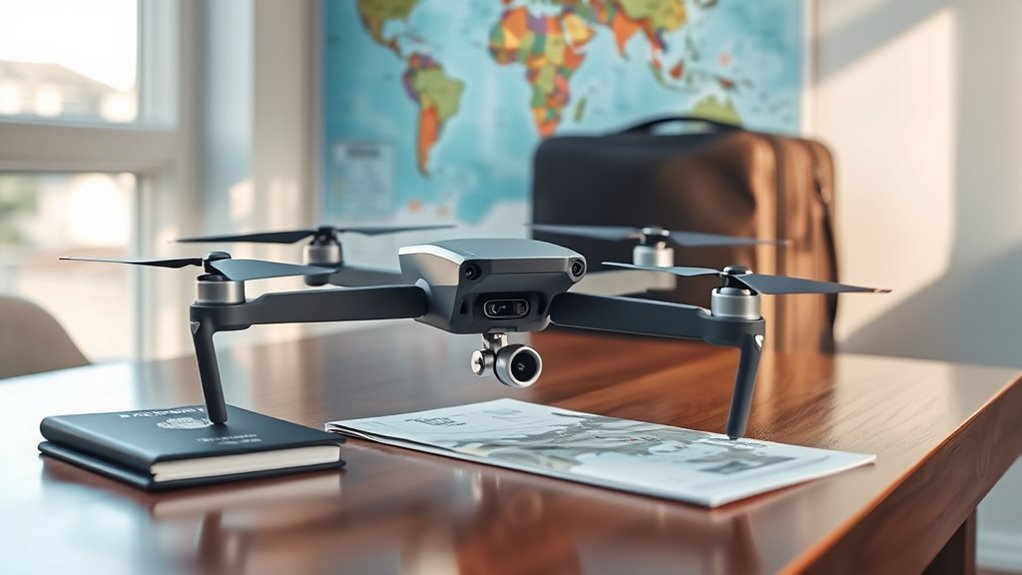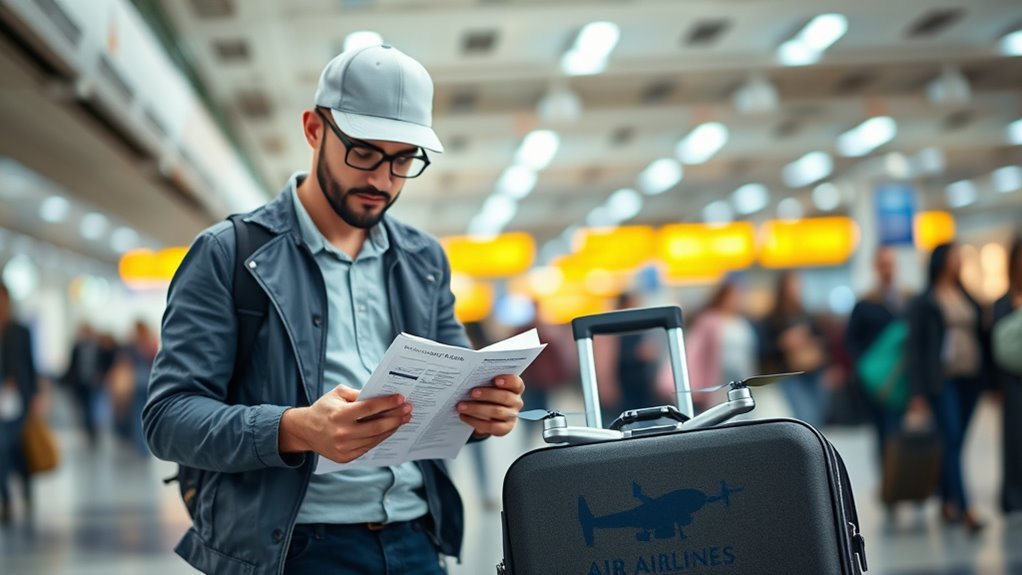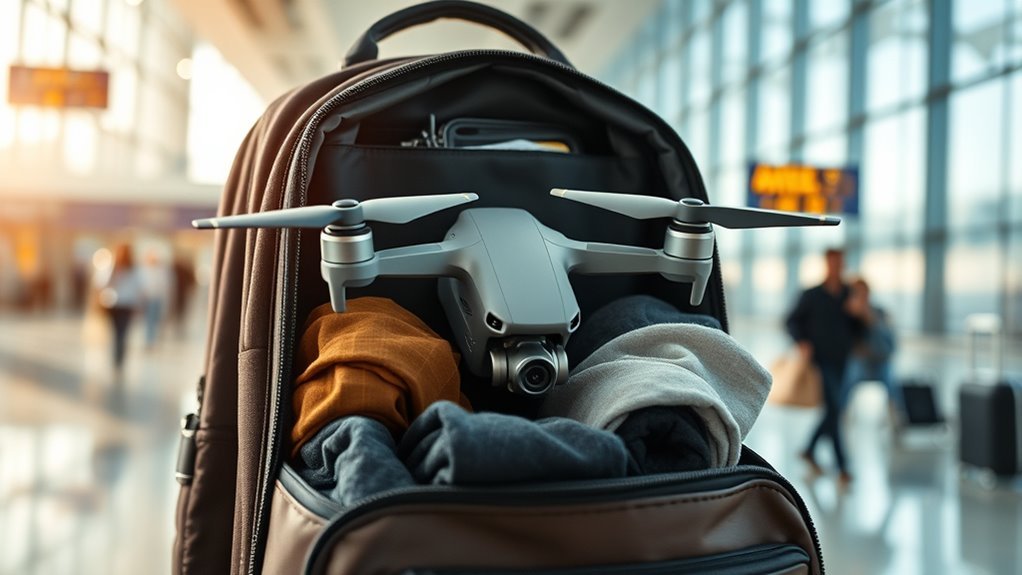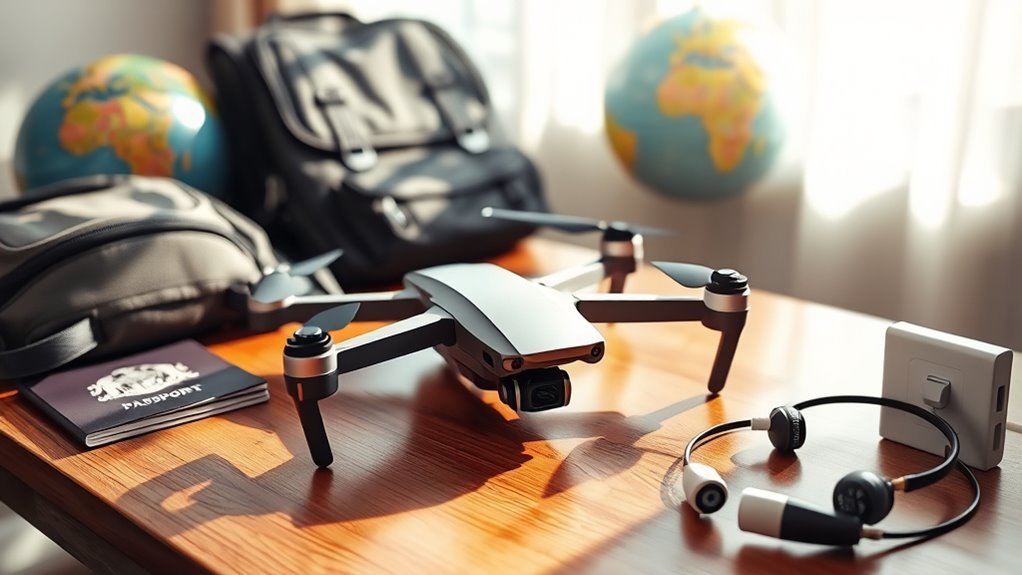When taking a drone on an international flight, you need to know the local laws at your destination, as regulations vary. Check airline policies for packaging and battery restrictions; some require hard cases while others allow soft bags. Confirm your drone is travel-ready by inspecting it and securing all components. Prepare for airport security checks, which may include removing your drone from its case. There’s a lot more to take into account, so keep exploring for more tips.
Understand the Legal Regulations of Your Destination

Before you pack your drone for an international flight, it’s crucial to understand the legal regulations of your destination. Each country has its own set of destination regulations that govern drone usage, including where you can fly and the altitude limits. Ignoring these rules could lead to hefty fines or confiscation of your equipment. To avoid complications, research whether you need to obtain drone permits ahead of time. Some countries require registration, while others may impose restrictions on specific areas, like urban zones or parks. By being informed and prepared, you can enjoy the freedom of capturing stunning aerial views without legal repercussions. Verify you’re compliant with local laws to make your drone experience smooth and enjoyable. Additionally, be aware that registration and necessary permits are often required before operating your drone in many jurisdictions.
Check Airline Policies for Carrying Drones

While you’re excited about capturing breathtaking aerial shots, it’s essential to check your airline’s policies regarding carrying drones. Different airlines have varying rules about drone packaging and battery restrictions. Make sure to review their guidelines to avoid surprises at the airport.
| Airline | Drone Packaging Requirements | Battery Restrictions |
|---|---|---|
| Airline A | Hard case required | Max 2 batteries, 100Wh max |
| Airline B | Soft bag allowed | Max 3 batteries, 160Wh max |
| Airline C | No specific packaging | Max 1 battery, 300Wh max |
Ensure Your Drone Is Travel-Ready

To guarantee your drone is travel-ready, it’s essential to inspect all components carefully before your trip. Start with drone maintenance; check for any wear or damage, making certain propellers and gimbals are secure. Clean the camera lens and body to avoid capturing unwanted debris in your shots. Next, focus on battery safety. Verify your batteries are fully charged but not overcharged, as this can lead to hazards during transport. Store batteries in protective cases and comply with airline regulations regarding lithium-ion cells. Additionally, be aware of local drone laws that may affect drone usage in your destination country, as some areas have strict regulations on flying drones. Finally, consider packing your drone in a sturdy, padded case to prevent damage. Taking these precautions will help you enjoy your travels without worry, allowing you the freedom to capture stunning aerial footage wherever you go.
Prepare for Security Checks at the Airport
As you prepare for your journey, it’s important to understand the security protocols at the airport, especially when traveling with a drone. Familiarize yourself with the security procedures specific to drones, as they might differ from standard luggage. Expect to remove your drone from its case during screening, and be ready to explain its purpose.
Keep in mind the baggage restrictions; some airlines limit the size and weight of carry-on items. Make sure your drone’s batteries comply with regulations, as lithium batteries can have strict limits. Arriving early can help ease your experience, allowing time for any unexpected queries. By being prepared, you can navigate security checks smoothly and keep your travel plans on track.
Research Local Drone Laws and Restrictions
Before you take your drone abroad, it’s crucial to research the local laws and restrictions that govern drone use in your destination country. Each location has its own set of local regulations, and failing to comply can lead to fines or confiscation of your equipment. Some countries require drone permits or registration, while others may impose altitude limits or restrictions on where you can fly. Additionally, ensure that your drone is compliant with registration requirements to avoid potential legal issues.
Here’s a quick reference table to help you:
| Country | Drone Permit Required | Maximum Altitude |
|---|---|---|
| USA | Yes | 400 ft |
| Canada | Yes | 400 ft |
| France | Yes | 150 m |
| Australia | Yes | 120 m |
| Japan | Yes | 150 m |
Always verify the rules before you fly!
Frequently Asked Questions
Can I Take Extra Batteries for My Drone on the Flight?
When you’re soaring high, don’t forget about battery regulations. You can take extra batteries, but check airline packing tips first. Keep them in carry-on luggage, ensuring they’re under the capacity limits to avoid turbulence.
What Should I Do if My Drone Is Damaged During Travel?
If your drone’s damaged during travel, assess the damage immediately. Explore drone repair options and check your travel insurance for coverage. Document everything thoroughly; it’ll help you file a claim or seek repairs more easily.
Are There Age Restrictions for Carrying a Drone Internationally?
When it comes to drone regulations, you’ll want to tread carefully. Many countries have age requirements, often requiring you to be at least 18. Always check local laws to avoid any surprises during your travels.
Do I Need Insurance for My Drone When Traveling?
You should consider drone insurance options when traveling, as it can protect you from potential damages. Additionally, reviewing travel insurance considerations is wise, ensuring your drone’s coverage aligns with your overall travel plans and adventures.
Can I Fly My Drone Upon Arrival Without Permission?
You can’t just fly your drone upon arrival without permission. Local regulations vary, and you’ll need to guarantee customs clearance is complete. Always check local laws to avoid potential fines or confiscation.

